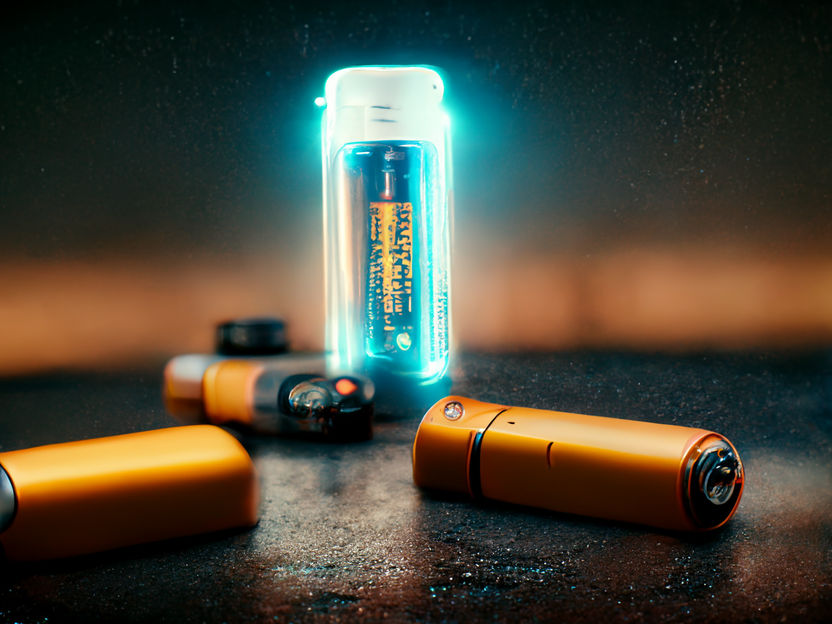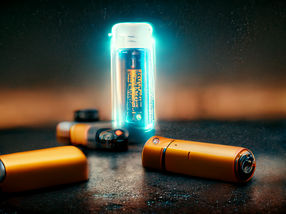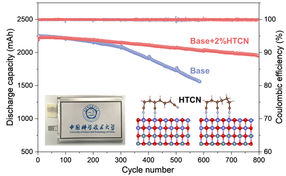How a common additive gives lithium-ion batteries a boost
Researchers have identified what makes a common electrolyte additive so effective at improving the performance of batteries using a lithium cobalt oxide cathode
Advertisement
Nitriles—an organic compound with a carbon atom triple-bonded to a nitrogen atom—are commonly added to the electrolyte formula for batteries using a lithium cobalt oxide cathode, making such batteries come much closer to realizing their full theoretical performance. Until now, battery researchers have not really understood why these nitriles work in this way. But a group of electrochemists have used advanced microscopy techniques to take a closer look at what happens at the molecular scale and identified what is going on, opening up new avenues for even further battery performance improvements.

Researchers identify how a common additive gives lithium-ion batteries a boost (symbolic image).
Computer generated picture

The electrochemical performance and the work mechanism of HTCN additive on high-voltage LiCoO2 cathode for practical pouch cells are comprehensively studied.
Nano Research


The study was published in the journal Nano Research on Sept.22, 2022.
Lithium cobalt oxide (LiCoO2, or just ‘LCO’) is the most widely used material for cathodes—the positive electrodes—in lithium-ion batteries. This is especially true for batteries used in portable electronic devices thanks to LCO’s high operating voltage, its high capacity and the stability of its performance over the long term.
But what has made LCO cathodes particularly attractive is that they offer more energy for a smaller amount of space (greater energy density), which is very useful for smaller consumer devices such as phones, smartwatches, and gadgets that have even more stringent space constraints such as household and industrial smart sensors.
However, at the moment, LCO cathodes can only deliver roughly half of their theoretical specific capacity. In plain language, this means that what they actually deliver is much less than what they should theoretically be able to produce. And so they often find it difficult to meet the increasing energy-density demands of portable electronics.
One way around this hurdle would be to increase the limited charge voltage of batteries using LCO cathodes. The limited charge voltage describes the point at which a battery is considered to be completely charged. Beyond this point, the battery could be harmed, and so many devices just shut off when the cut-off threshold is hit. This threshold is somewhat arbitrarily set, and so it could be increased, and such high-voltage operation does offer promise for giving an energy density boost to such batteries.
But here a new problem arises: high voltage operation can exacerbate harmful chemical reactions at the interface between the cathode and the electrolyte. This can result in cracks and other internal damage, which in turn can further deteriorate the interface between the electrodes. Ultimately, all of this can result in a radical decline in battery capacity and a sharp increase in safety issues. The working temperature in these devices can hit 45℃ due to their own heat generation, further shortening battery life.
And so for some time now, mixing in additional compounds to the electrolyte formula to tweak the reaction activity of the electrolyte (the medium containing ions that helps establish a current via the movement of positive and negative ions through it) at the interface between the cathode and electrolyte has proven to be a very effective strategy to decrease the electrolyte reaction activity.
There are a number of different compounds used as such electrolyte additives, but for lithium-ion batteries, nitriles are perhaps the most widely used. Nitriles are any organic compound that has a section of the molecule (a ‘functional group’) made up of a carbon atom triple-bonded to a nitrogen atom.
However, the working mechanism of nitrile additives on high-voltage cathodes is still not fully understood, particularly in the sort of practical, everyday high-voltage LCO pouch batteries. (Pouch batteries are a type of ‘soft’ battery without a hard metal casing, and instead whose components are enclosed in an aluminium-coated plastic film, looking a bit like a ‘pouch’ of chewing gum or loose tobacco. First developed in 1995 and allowing much more efficient use of space, pouch batteries have since become a common choice for manufacturers due to this design advantage.)
There are two main theories that try to explain the mechanism of nitrile additives, but both have significant shortcomings in their explanatory power.
“Nitriles work well, but we don’t really know why they work well, why this stabilizing action is occurring. Exactly what is going on has remained pretty mysterious,” said Shuhong Jiao, an electrochemist at the University of Science and Technology of China (USTC). “And if we don’t know why what we’re doing to improve batteries is working, this prevents us from tuning our efforts to improve things even further.”
So the researchers took a common nitrile electrolyte additive, tridentate ligand-containing 1,3,6-hexanetricarbonitrile (or more simply HTCN) to try to shed light on what the mechanism is of nitriles in stabilizing high-voltage a LiCoO2 cathode.
While the battery was operating, and far outperforming an equivalent without the HTCN electrolyte additives, the researchers used electron microscopy to have a closer look at what was happening, combined with an analysis of the ion and elemental composition of the system. They found that the HTCN additive was very effectively inhibiting the generation of cracks and the dissolution of cobalt ions.
Then, using X-ray photoelectron spectroscopy combined with a series of theoretical calculations, they found that the HTCN molecules were being efficiently adsorbed on to (stuck to) the surface of LCO and embedded in the interface between the cathode and the electrolyte, which in turn greatly inhibit an oxidation reaction on the surface of the LCO, thereby preventing a continuous decomposition of the electrolyte.
Altogether, this amounts to a much more stable interface between cathode and electrolyte, which significantly suppressed decomposition of components and formation of cracks. It is this stable and dense cathode-electrolyte structure that enhances the stability of the battery through a great many cycles of charging and discharging.
Knowing this molecular-level understanding of how nitrile additives give such batteries a boost, researchers can now seek out other electrolyte additive formulations that produce a similar or better interface structure.


































































